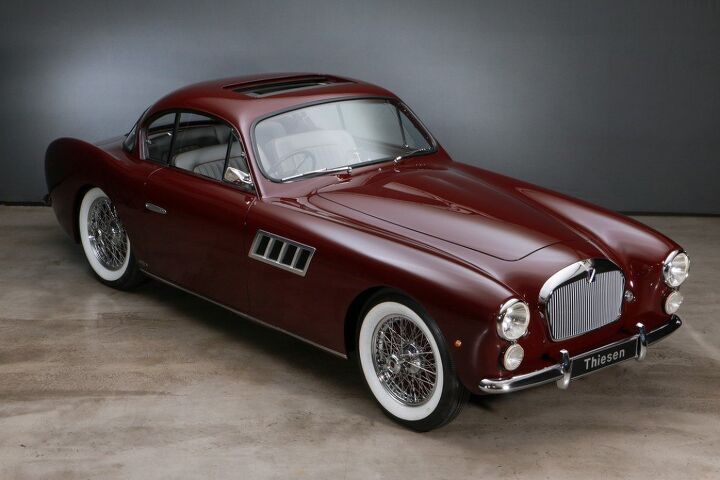Rare Rides: The 1954 Talbot-Lago T26 Grand Sport Coupe - Supreme Elegance (Part II)

In Part I of this two-part edition of Rare Rides, we learned about historic manufacturer Talbot and the ups and downs the performance and luxury car brand experienced due to outside forces. Today we take a closer look at the car which generated this story — a very rare T26 Grand Sport coupe.
Talbot-Lago introduced its new coupe in the fall of 1947 amid brewing financial difficulties. The existing T16 Grand Sport model donated its chassis for the new version, but Talbot wanted a shorter coupe. And they weren’t kidding — the T16 chassis was 123 inches long, but after engineers at Talbot finalized the T26 version, just 104 inches remained. This “Extra Short Chassis” entered series production in 1948. For customers who wanted more space, Talbot also offered a “Longue” version of their super short chassis, which measured in at 110 inches.
Notable for its performance, the 4.5-liter inline-six engine from the Record was tuned up to 190 or 195 horsepower. The engine’s considerable power was achieved through features like triple carburetors and a hollowed-out camshaft. Top speed was around 124 miles per hour, depending on what sort of body the owner fitted. Well suited for racing or luxury duty, the T26 was one of the most powerful production cars in existence at the time.
The dual-purpose of the T26 Grand Sport was one of the things that made it special compared to other Talbot-Lago offerings. With few exceptions, Talbot built its own bodies. When it came to the Grand Sport, however, rules were flipped. The T26 was sold only as a chassis, with customers selecting bespoke bodywork from the coachbuilder of their choice.
Production started out slowly, and in its first full year of 1948 just 12 examples of the Grand Sport were made. Talbot kept building the T26 at a very slow pace. Though the model continued through early 1955, only around 20 were made in total.
Talbot continued building cars until 1959, though it was under government debt protection after 1951. After it entered bankruptcy again, Mr. Lago reached an agreement to sell his company to Simca. His business taken away, Antonio Lago passed away the next year. Talbot and Simca eventually fell under the Rootes Group and then to Chrysler Europe, which released that last gasp Tagora under a renewed Talbot brand in the Eighties.
Today’s beautifully restored T26 currently lives in Germany, and is one of the Longue models. It has a four-speed on the tree and 97,000 kilometers on the clock, and asks $435,000.
[Images: seller]

Interested in lots of cars and their various historical contexts. Started writing articles for TTAC in late 2016, when my first posts were QOTDs. From there I started a few new series like Rare Rides, Buy/Drive/Burn, Abandoned History, and most recently Rare Rides Icons. Operating from a home base in Cincinnati, Ohio, a relative auto journalist dead zone. Many of my articles are prompted by something I'll see on social media that sparks my interest and causes me to research. Finding articles and information from the early days of the internet and beyond that covers the little details lost to time: trim packages, color and wheel choices, interior fabrics. Beyond those, I'm fascinated by automotive industry experiments, both failures and successes. Lately I've taken an interest in AI, and generating "what if" type images for car models long dead. Reincarnating a modern Toyota Paseo, Lincoln Mark IX, or Isuzu Trooper through a text prompt is fun. Fun to post them on Twitter too, and watch people overreact. To that end, the social media I use most is Twitter, @CoreyLewis86. I also contribute pieces for Forbes Wheels and Forbes Home.
More by Corey Lewis
Latest Car Reviews
Read moreLatest Product Reviews
Read moreRecent Comments
- MaintenanceCosts 308/311 is just the rating of the gas engine by itself. The full powertrain power rating, taking into account both power sources is 483/479. The car will do 0-60 in under five seconds. Frankly, I find the idea of that being "underpowered" bizarre.Also, "understated" has never been less fashionable within my lifetime. We are in a moment where everyone wants to make a Bold Statement with everything they do.
- 28-Cars-Later @PoskySo here's some interesting data, Manheim's Used Car index is still 28% higher than shortly before the Plandemic (155 on chart) after declining from a height of 39% (roughly 215) in January 2022, yet interest rates are now more than double on average. Maybe the White House should focus on some deflationomics instead of mucking up everything?
- Dale Had one. The only car I ever bought because of a review in a guitar magazine.Sure was roomy inside for such a small car. Super practical. Not much fun to drive even with a manual.Sent it to college with my stepson where it got sideswiped. Later he traded it in on an F-150.
- Bd2 Hyundai's designs are indeed among the most innovative and their battery technologies should allow class leading fuel consumption. Smartstream hybrids are extremely reliable.
- 28-Cars-Later So now H/K motors will last longer in between scheduled replacements. Wow, actual progress.







































Comments
Join the conversation
Interesting resides in Germany, has a speedo in km/hr, French language controls, and Left Hand Drive! Post war export model to the UK?
*SO* pretty . -Nate